
 |
|
|
#1 |
|
Member
Join Date: Dec 2005
Posts: 164
|
I realize this is not a ethnographic sword but I thought perhaps some of you folks might be able to help me get more detailed information.
I brought this one home today. I am pretty sure it is a Artillery Officer's Sword but I am just a little confused on the era. I believe it is 1812 but am not sure I recognize the makers mark as the importer Schnitzler and Kirschbaum. 
Last edited by Alan62; 7th January 2007 at 04:31 AM. |
|
|

|
|
|
#2 |
|
Member
Join Date: Dec 2005
Posts: 164
|
Is Jim McDougal in the room,paging Jim.
Sorry just kidding around ,he has helped me with older non ethno swords in the past. |
|
|

|
|
|
#3 |
|
Arms Historian
Join Date: Dec 2004
Location: Route 66
Posts: 10,735
|
Hi Alan,
You rang?!!!  While military and regulation patterns arent necessarily ethnographic, they are very much associated and I think they bring some very pertinant perspective into our general studies. What you have here appears to be a very nice example of an early 19th century British yeomanry officers sabre. These stirrup hilted sabres tended to follow the basic typology of the M1796 cavalry sabres, but typically there was a greater degree of variation in these volunteer cavalry swords. The gilded hilt and ribbed ivory grips were characteristic of these swords and the basic hilt form including langets are consistant with examples of c.1810-30's. Schnitzler & Kirshbaum were of course Solingen smiths who produced many swords for Great Britain and had been in business since about 1787, so were well established as exporters by this time. While later swords were typically stamped with S & K , there was a trend of marking swords in cursive around the late 1820's through 30's in Solingen it would appear. This certainly was not exclusively the case, however there seem to be a considerable number of examples that reflect this feature. Nicely patinated example...just the way I like em!!!!  Very nice! Very nice!Thanks for sharing this one Alan, All the best, Jim |
|
|

|
|
|
#4 |
|
Member
Join Date: Dec 2005
Posts: 164
|
Thank you Jim,
I will hang this one right next to the last one you helped me on remember this one...... 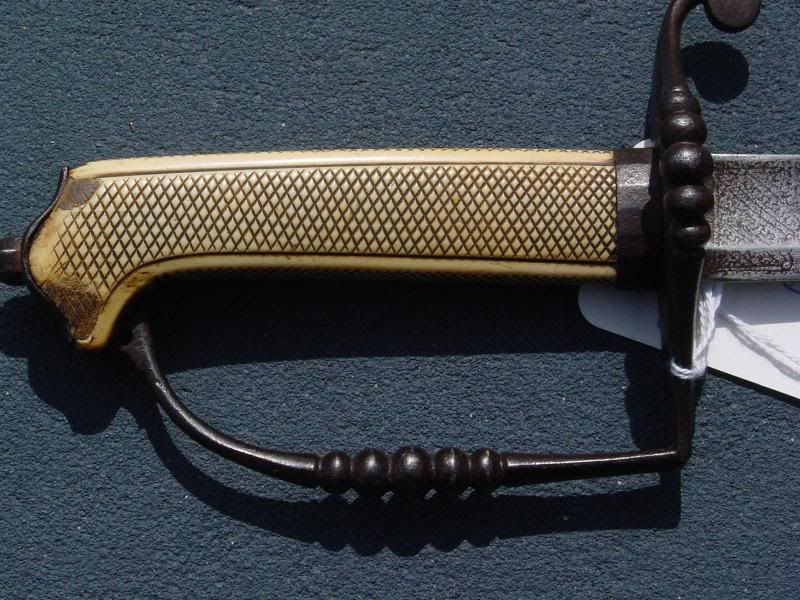 Thanks agaian Jim for your very detailed information |
|
|

|
|
|
#5 |
|
Arms Historian
Join Date: Dec 2004
Location: Route 66
Posts: 10,735
|
I sure do Alan!!! Extremely nice swords that will go great together!!!
 All the best, Jim |
|
|

|
|
|
#6 |
|
Member
Join Date: Dec 2005
Posts: 164
|
Jim if I may impose did you see the Moro Kris and do you have any thoughts on it.
Thanks again a link to my other thread http://www.vikingsword.com/vb/showthread.php?t=3870 |
|
|

|
|
|
#7 |
|
Arms Historian
Join Date: Dec 2004
Location: Route 66
Posts: 10,735
|
Hi Alan,
On the topic of Moro weapons I'll defer to Rick and some of the others who have outstanding knowledge on them, and as always look forward to the responses!  Best regards, Jim |
|
|

|
|
|
#8 |
|
Member
Join Date: Dec 2005
Posts: 164
|
Ok Thank you Jim ,Your information and oppinions are very important to me and I greatly appreciate it..... here is a sneak peek at the next one I will be bringing home.It is not a real good photo (I took it with my cell phone)
Thanks again 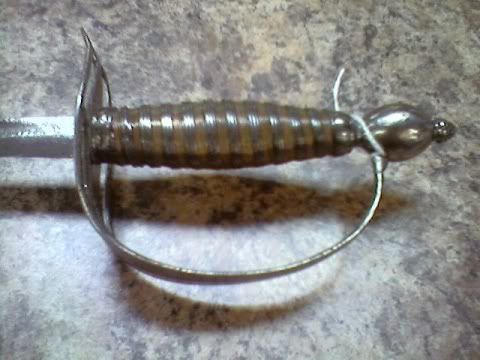
|
|
|

|
|
|
#9 |
|
Arms Historian
Join Date: Dec 2004
Location: Route 66
Posts: 10,735
|
Thanks Alan!
 Man, you're doing pretty well here!! This looks at the outset like a British officers sword of 18th century, probably Revolutionary War period. I'll wait for more photos, but the hilt looks good, gadrooned band wrap...is this hilt silver mounted? All the best, Jim |
|
|

|
|
|
#10 |
|
Member
Join Date: Dec 2005
Posts: 164
|
Thanks Jim,Yes I believe it to be a silver hilted sword from the late 1700's. I will be bringing it home this coming weekend and will have more detailed pics.It is a very nice one, the blade is very similar to the ivory hilted one with the crosshatching from before....I can't wait to get home and learn more.
 Ps can you descibe silver mounted for me Thanks |
|
|

|
|
|
#11 |
|
Member
Join Date: Dec 2005
Posts: 164
|
While I am thinking about it do you or anyone else recognize hallmark on this Briquet style saber, It appears to be FC and is stamped in the ricasso . I understand that these swords were widley used by many
 ethnicities ie. French ,Spanish,Italian,Polish,German and probably more.I am trying to determine who made and what origin this one has. ethnicities ie. French ,Spanish,Italian,Polish,German and probably more.I am trying to determine who made and what origin this one has.It is funny ,These short sabers do not command big dollars and seem to be very plentiful but when it comes to holding a sword in My hand, this one fits and feels more useful than any sword I have ever held and would most likely be my choice in a battle. Thanks for any input 
|
|
|

|
|
|
#12 |
|
Member
Join Date: Dec 2005
Posts: 164
|
Jim
Here are the new pics of the silver hilt, Thanks for your input   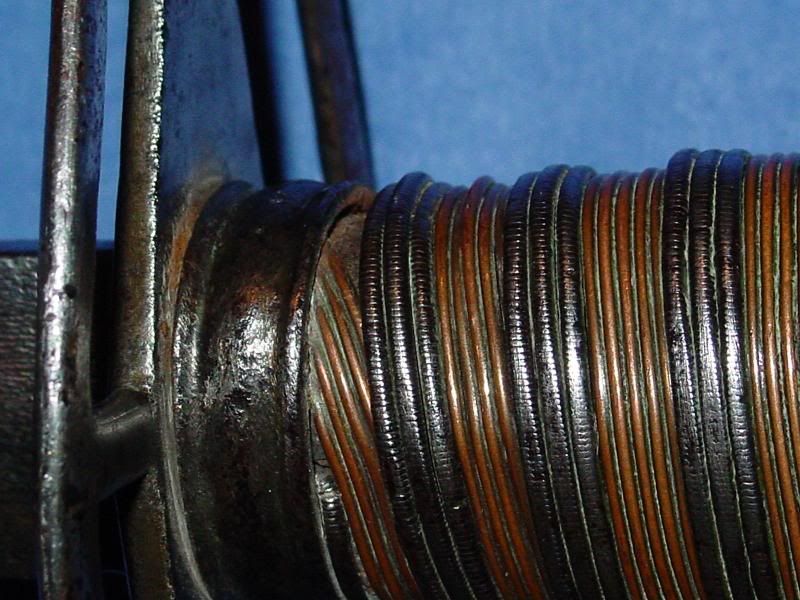 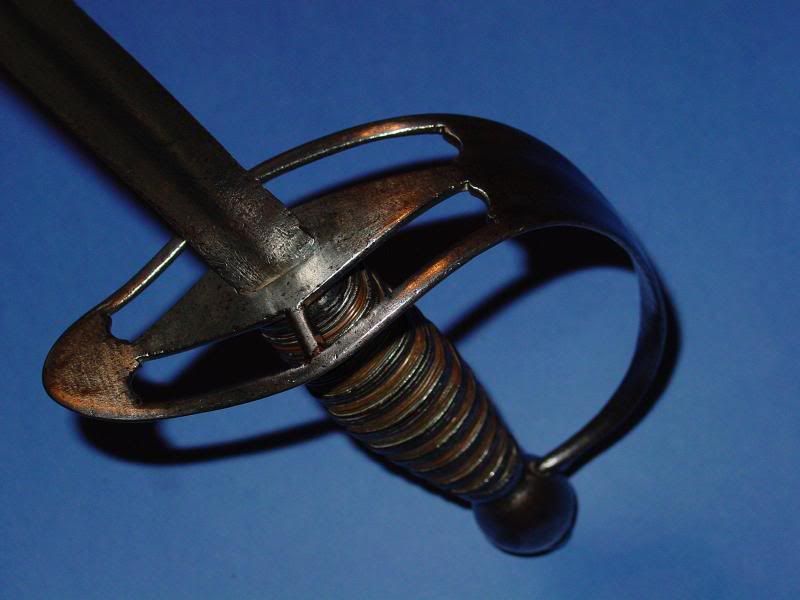 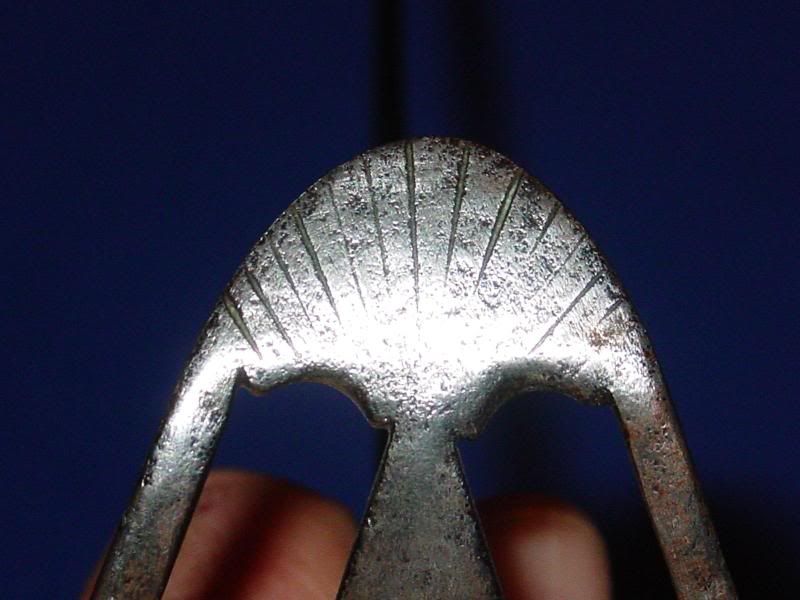   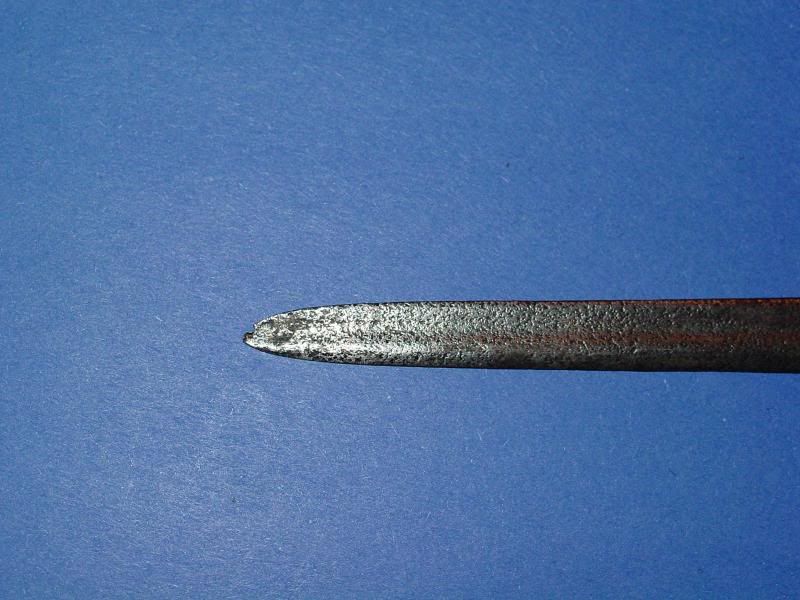
|
|
|

|
|
|
#13 |
|
Member
Join Date: Dec 2006
Posts: 13
|
Alan - lovely sword, but a steel hilt rather than silver surely?
Paul |
|
|

|
|
|
#14 | |
|
Member
Join Date: Dec 2005
Posts: 164
|
Quote:
Perhaps you or Jim can shed some light on it for me. Paging Jim McDougall 
|
|
|
|

|
|
|
#15 |
|
Member
Join Date: Dec 2006
Posts: 13
|
Alan - to me 'silver hilted' means just that. Pommel, guard etc in silver. I have seen silver-hilted spadroons but I'd be amazed if yours was - not just from the colour (and here I'm referring to the shade of the polished areas) but the pitting visible on the close-up shots of the hilt. Silver goes black and wears smoothly from polishing, I've never seen it pit like iron does. I expect the triple stranded wire wrap over the copper on that beautifully wrapped grip is silver but nothing else.
Still a fine late C18 military officer's sword though. How long is the blade and are there any markings on it? Paul |
|
|

|
|
|
#16 |
|
Member
Join Date: Dec 2005
Posts: 164
|
Thanks Paul
I thought they may just be casting flaws where polishing cannot reach, but they are probably just pits I am still very happy with the purchase and look forward to more detailed information on this sword. Its blade is 30.25 inches long with a 29.25 inch fuller that runs all the way to the tip of the blade.The blade is .75 inch at the ricasso and a little over 3/16ths on the spine at the hilt. There are no visible makers marks Thanks again |
|
|

|
|
|
#17 |
|
Arms Historian
Join Date: Dec 2004
Location: Route 66
Posts: 10,735
|
Hi Alan,
Beautiful patination on this one!!  As noted, I believe this to be a British officers short sabre of 18th c. and a remarkably similar iron hilt to your example is shown in "Swords and Blades of the American Revolution" (George C. Neumann, Stackpole, 1973, p.106, #134.S). This example of these 'four slot' hilts has the same pommel/capstan and gadrooned grip. These apparantly were favored by both British and American officers. It should be remembered that in this period, c.1775-1780, individuals all were essentially considered British. The straight blade on yours is straight, and similar to those seen on similar 'short sabres' c.1760 (Neumann, op.cit. #133.5). In this period through the 1790's some straight bladed swords were termed sabres, and the term 'spadroon' was also applied. I think Paul can probably better elaborate on the application of these terms as his knowledge on military swords of this period is well known. I find the striations at the front of the guard most interesting, as they may represent influences other than simply aesthetic decoration, and it would be interesting to seek others opinions. These may be stylized marks recalling the scallop shell guards of earlier English hangers, or possibly even similar striations seen on Spanish shellguard weapons of this period. From a more esoteric perspective, it should be noted that there are distinct possibilities of Masonic associations and symbolism, and naturally in these times, both Colonial and British officers, typically as gentry, often had such Masonic affiliation. Any ideas guys?  All best regards, Jim |
|
|

|
|
|
#18 |
|
Member
Join Date: Dec 2005
Posts: 164
|
Thank You again Jim for your very detailed and for a lack of a better term
!Awsome! explaination and assesment of this sword. Did you see the briquette style sword from a few posts back and is there any chance you might have info on the makers mark FC Thank You again so much |
|
|

|
|
|
#19 |
|
Arms Historian
Join Date: Dec 2004
Location: Route 66
Posts: 10,735
|
Hi Alan,
You bet! Absolutely my pleasure, and I appreciate very much the opportunity to see these great weapons you keep finding!  The briquet is as you note, a most serviceable sidearm, which is probably why it was copied so consistantly by nearly every European army at the turn of the century c.1800. I have one that I have owned for over 40 years! one of my very first swords, and it has a cast cartouche in the hilt at the center of the crossguard with initials PS. I researched for many years, but never found any satisfactory possibility. Always convinced that it was British, in later years I discovered that it may possibly be Spanish, and the wedge shaped heavily patinated blade seems consistant with Spanish colonial weapons I have seen of this period. It seems I moved on to other projects as this one seemed so inconclusive, especially with the incredibly broad diffusion of this form. There was however, a bizarre Spanish colonial hybrid with the 'Spanish motto' blade (see the thread with Matt Branch's sword) mounted with an altered briquet hilt, and loosely mounted three bar cavalry hilt of c.1820's. On the frontier in Mexico in the 19th c. and nearly unto to 20th c. there seem to be numerous extremely crudely done 'blacksmith' hybrids, and I mention this one only because of the briquet hilt component. Unusual to see one with a scabbard! What is the blade length, details? All best regards, JIm |
|
|

|
|
|
#20 |
|
Member
Join Date: Dec 2005
Posts: 164
|
The blade is 23 inches long from the tip to the center of the ricasso nearest the hilt as the blade is slightly curved, it is 1 and 3/8 wide at the ricasso and the spine is 3/8s of an inch thick at the ricasso. I believe the scabbard to be original to the sword.As deep as I can see on the inside of it, shows signs of age .I looked at many reproduction scabbards and never found one made quite like this one.But you never know.
Like I said in the previous post about this one,I would probably pick it up first if someone strange came walking into my house or I were off to battle.It is a very stout little weapon Thanks again for all the info That is if I didn't pick up this stout little guy first.... ....for your viewing pleasure, just cause I figure you can appreciate it 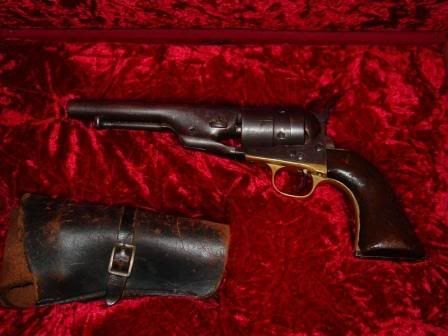 Its a Colt 44 M1860 Army with factory Richardson conversion  It belonged to my Greatgrandfather ,So I guess that makes it a Texan or Tex-nographic It belonged to my Greatgrandfather ,So I guess that makes it a Texan or Tex-nographic  weapon weaponSorry I got a little carried away 
Last edited by Alan62; 16th January 2007 at 05:52 AM. |
|
|

|
|
|
#21 |
|
Member
Join Date: Oct 2006
Posts: 36
|
Hi Alan, that is a nice revolver, If you have the serial number you might be able to see who it was issued to at the Springfield Research Service.
There is a link to it on HTML Code:
http://armscollectors.com Matt |
|
|

|
|
|
#22 |
|
Member
Join Date: Dec 2005
Posts: 164
|
Thanks Matt
There is the original Colt SN and the 2nd SN from when it had its Colt factory Richardson Conversion so it actually has 2 sets of matching SN's It also has a US stamp from its time as a Government issue ,but most important to me is that it was my Greatgrandfather's when he was a Jailer at the Navarro County jail at shortly after the turn of the century in Corsicana Texas, but I will check out the link Thanks |
|
|

|
 |
|
|